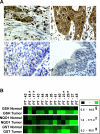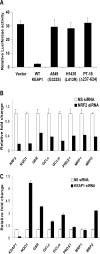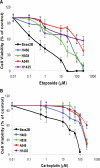Dysfunctional KEAP1-NRF2 interaction in non-small-cell lung cancer
- PMID: 17020408
- PMCID: PMC1584412
- DOI: 10.1371/journal.pmed.0030420
Dysfunctional KEAP1-NRF2 interaction in non-small-cell lung cancer
Abstract
Background: Nuclear factor erythroid-2 related factor 2 (NRF2) is a redox-sensitive transcription factor that positively regulates the expression of genes encoding antioxidants, xenobiotic detoxification enzymes, and drug efflux pumps, and confers cytoprotection against oxidative stress and xenobiotics in normal cells. Kelch-like ECH-associated protein 1 (KEAP1) negatively regulates NRF2 activity by targeting it to proteasomal degradation. Increased expression of cellular antioxidants and xenobiotic detoxification enzymes has been implicated in resistance of tumor cells against chemotherapeutic drugs.
Methods and findings: Here we report a systematic analysis of the KEAP1 genomic locus in lung cancer patients and cell lines that revealed deletion, insertion, and missense mutations in functionally important domains of KEAP1 and a very high percentage of loss of heterozygosity at 19p13.2, suggesting that biallelic inactivation of KEAP1 in lung cancer is a common event. Sequencing of KEAP1 in 12 cell lines and 54 non-small-cell lung cancer (NSCLC) samples revealed somatic mutations in KEAP1 in a total of six cell lines and ten tumors at a frequency of 50% and 19%, respectively. All the mutations were within highly conserved amino acid residues located in the Kelch or intervening region domain of the KEAP1 protein, suggesting that these mutations would likely abolish KEAP1 repressor activity. Evaluation of loss of heterozygosity at 19p13.2 revealed allelic losses in 61% of the NSCLC cell lines and 41% of the tumor samples. Decreased KEAP1 activity in cancer cells induced greater nuclear accumulation of NRF2, causing enhanced transcriptional induction of antioxidants, xenobiotic metabolism enzymes, and drug efflux pumps.
Conclusions: This is the first study to our knowledge to demonstrate that biallelic inactivation of KEAP1 is a frequent genetic alteration in NSCLC. Loss of KEAP1 function leading to constitutive activation of NRF2-mediated gene expression in cancer suggests that tumor cells manipulate the NRF2 pathway for their survival against chemotherapeutic agents.
Conflict of interest statement
Figures







References
-
- Spiro SG, Silvestri GA. The treatment of advanced non-small cell lung cancer. Curr Opin Pulm Med. 2005;11:287–291. - PubMed
-
- Tsai CM, Chang KT, Perng RP, Mitsudomi T, Chen MH, et al. Correlation of intrinsic chemoresistance of non-small-cell lung cancer cell lines with HER-2/neu gene expression but not with ras gene mutations. J Natl Cancer Inst. 1993;85:897–901. - PubMed
-
- Tew KD. Glutathione-associated enzymes in anticancer drug resistance. Cancer Res. 1994;54:4313–4320. - PubMed
-
- Young LC, Campling BG, Cole SP, Deeley RG, Gerlach JH. Multidrug resistance proteins MRP3, MRP1, and MRP2 in lung cancer: Correlation of protein levels with drug response and messenger RNA levels. Clin Cancer Res. 2001;7:1798–1804. - PubMed
-
- Soini Y, Napankangas U, Jarvinen K, Kaarteenaho-Wiik R, Paakko P, et al. Expression of gamma-glutamyl cysteine synthetase in nonsmall cell lung carcinoma. Cancer. 2001;92:2911–2919. - PubMed
Publication types
MeSH terms
Substances
Grants and funding
LinkOut - more resources
Full Text Sources
Other Literature Sources
Medical
Molecular Biology Databases
Research Materials

